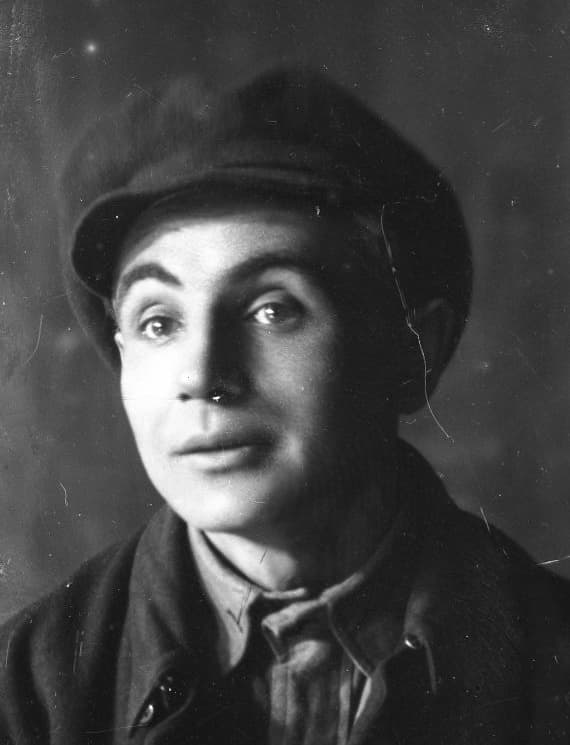Play in 3 acts by Ivan Mykytenko
Premier: May 28, 1931
Adaptation: Les Dubovyk
Stage Design: Dmytro Vlasiuk and Yevhen Tobin
Music: Yulii Meitus
Member of Director’s Lab: O. Ishchenko
Cast
Students:
Olena Chereda – Nataliia Uzhvii, Lidiia Krynytska
Teren Kryzhen – Les Serdiuk
Taras Workaholic – Vasyl Stetsenko
Mosia Shkinder – Marian Krushelnytskyi, Oleksa Flantsman
Katria Hrytsenkova – Lesia Datsenko
Neronov – Serhii Khodkevych
Vasyl Smola – Dmytro Miliutenko, Svitskyi
Mykola Priadka – Mykola Nazarchuk
Antonio – Mykola Savchenko
Varka – Vashchenko
Mamieva – Iryna Steshenko
Riaboshapka – Andrii Shutenko
Fitskyi – Ivan Havryshko, Yevhen Ponomarenko
Hrushkina – Yevheniia Petrova, Valentyna Bzheska
Kira Bohoiavlenska – Olimpiia Dobrovolska
Homeless Kotia – Yosyp Hirniak
Professors:
Rector Harmash – Ivan Marianenko, Oleksandr Khvylia
Bohoyavlenskyi – Danylo Antonovych
Bilyi – Oleksandr Romanenko, Roman Cherkashyn
Voronov – Oleksandr Yailo
Kocherha – Hryhorii Kozachenko
Kukushkin – Andrii Makarenko
Sliozkin – Mykhailo Zhadanivskyi
Assistant – Hanna Lor
Yuliia Bulatovych – Klavdiia Pilinska
Kuma – Antonina Smereka
Manka – Tsymbal
Shpak – Yevhen Bondarenko, Mykola Pishvaniv
Byk – Verkhatskyi
Students:
Balabanova, Valentyna Bzheska, Herasimova, O. Vereshchynska, Pavlovskyi, Tamara Zhevchenko, Yaroslava
Kosakivna, Yuliia Fomina, Sydorenko, Varvara Kostiuchenko, Kudlai, Nemzer, Vinnichuk, Rohov, Koval,
Bartashevych, Hanna Kovalenko, Zdanivskyi, Milcho, Chentsova
Assistant Director: Oleksandr Savytskyi
Stage Inspector: V. Tsvytsyshyn
Stage Engineer: S. Chaplyhin
F. Pozdniakov
K. Kolenko
P. Kramich
A. Fedotov, P. Kliovin
The premier of Ivan Mykytenko’s Cadres took place on May 28, 1931 at the Berezil Theater. The socio-political play tells the story of the revolutionary enthusiasm of proletariat and poor university youth. But the new future cadres of the socialist society easily give in to the provocations of “enemies of the proletariat.” The leader among these “enemies” is bandit Halashchuk, who pretends to be poor and gains the students’ trust. It is they who later expose his counterrevolutionary past. Other negative figures also appear on stage: professor Sliozkin, students Antonio, Fitskyi and Hrushkina (who are opposed by a cohort of neophytes led by miner Kryzhen). There is no main character in the play: Mykytenko recreated a kaleidoscope of social masks, so-called new cadres, and painted the image of a socialist collective that is hardened from 1922-1927.
In addition to being staged at Berezil by director Les Dubovyk, the play was performed at the Ivan Franko Theater, Odesa Theater of the Revolution, and Kharkiv Chervonozavodskyi Theater. All these productions were ordered by the authorities, so it’s hard to talk about original interpretations and objective reviews in the press. For example, the reporter’s ideological bias is obvious in the following review of Cadres: “Berezil put on a thoughtful, vivid and ideologically consistent and sound play.” [2] The situation was similar with the analysis of the acting (“I don’t want to dwell on individual artists because obviously it wasn’t possible to add more detail and description to individual characters – the most important thing for the play was the social and class characteristics, and here the directors avoided everything that was secondary.
As for the acting of such masters as Hirniak and Krushelnytskyi, who had exceptionally ‘winning’ comic roles in the play, they consciously, obviously, (and correctly) did everything to obscure the comic parts and avoided the slightest caricature so as not to distract the audience from the main line of the play and not dissolve the intense tone of struggle and enthusiasm.”
The claim that Yosyp Hirniak and Marian Krushelnytskyi deliberately suppressed their acting skills sounds unconvincing. Yu. Dyvnych’s (pseudonym Yurii Lavrinenko) memoirs provide a better understand, for example, of how Hirniak portrayed the young Kotia: “The ability not to repeat was manifested in the contrast between the roles of Grandpa Yukhym and Koria in Cadres. Here the acting technique and skill give the image of a naïve boy, a homeless victim of the revolution who lost his parents at a young age but didn’t lose his humor and lyricism, and through his talents enters university along with other peasant boys (although at the beginning of the play he is cleaning the shoes of passersby on the street and learning to read from signs). And here the actor is able to find in the dead half of the Soviet text of the play a living grain of truth and to grow an image in front of the audience that would be interesting for decades to come. An image of people who, thrown to the bottom of an idiotic society and regime, can endure and move ahead without losing their human soul.” Hirniak’s collective image of Kotia reflected the fate of thousands of real homeless children in the new republic.
The term “realism” was used repeatedly in discussions about this play. For example, one of the contributors to the article “On the topic realism” emphasized: “We have been given the direction which way to go to have a show about cadres in our proletarian theater. The director did this only because he took a purely realistic approach. […] Cadres is about poor, proletarian, student youth. Cadres is about class struggle in the school.”. Berezil’s Cadres was also a formative struggle between Les Kurbas’s romantic “expressive realism” and the pressure of the socialist regime of the 1930s.

